#Basilica of St. John Lateran
Text
The Rule of the Benedictines, the Black Monks of Europe | Ancient Origins
https://www.ancient-origins.net/history-ancient-traditions/benedictines-0012960

View On WordPress
#1220#1581#16th century#1964#19th century#4 January 1888#480 AD#529 AD#547 AD#595 AD#6th century#816#817#Abruzzi#Affile#Austria#Basilica of St. John Lateran#Belgium#Benedictine Confederation#Benedictine Order#Black Monks#Brazil#canonization#Charlemagne#Christianity#Dialogues#Enfide#England#Europe#France
0 notes
Text
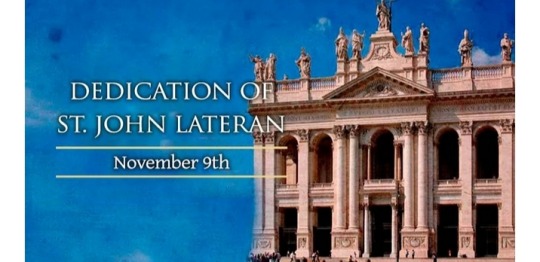
The feast of the Dedication of the Basilica of St. John Lateran is celebrated by the entire Church.
It marks the dedication of the cathedral church of Rome by Pope Sylvester I in 324.
The Lateran Basilica is the cathedral church of the Diocese of Rome and the official ecclesiastical seat of the Bishop of Rome, who is the Pope.
It is the Papal Archbasilica. It is the oldest public church in the west and ranks first among the four Major Basilicas of Rome, all of which are papal.
A Latin inscription in the Church reads:
“Omnium ecclesiarum Urbis et Orbis mater et caput.”
Translated, this means:
“The mother and head of all churches of the city and of the world.”
The basilica was originally named the Archbasilica of the Most Holy Savior.
However, it is called St. John Lateran because it was built on the property donated to the church by the Laterani family.
The monks from the monastery of St. John the Baptist and St. John the Divine also served it.
A chapel dedicated to Saint John the Baptist was built inside it, which served as the baptistry.
This moved Pope Sergius III to dedicate it to Saint John the Baptist as well. Lastly, Pope Lucius II also dedicated it to Saint John the Evangelist in the 12th century.
Thus, the name of this Papal Basilica is the Basilica of the Most Holy Savior and of Saints John the Baptist and John the Evangelist in the Lateran.
Christians consider the Basilica to be the mother church of all churches in the world.
The church was destroyed several times in the course of the centuries and always rebuilt.
The final reconstruction took place under the pontificate of Benedict XIII.
The church was rededicated in 1724. It was at that time that the feast celebrated today was established and extended to the universal Church.
#Feast of the Dedication of the Basilica of St. John Lateran#Dedication of the Basilica of St. John Lateran#Laterani Family
4 notes
·
View notes
Link
There are innumerable churches in the world but Basilica San Marco, Duomo Di Milano, and Duomo Di Siena are one of the best churches in Italy. These cathedrals have an astonishing and impressive appearance. Add these to your bucket list & take an amazing experience to explore Italy. For more information read this - https://www.benvenutolimos.com/blog/top-italian-churches-for-your-bucket-list/
#best churches in Italy#basilica san Marco#duomo di Milano#duomo di Siena#Italy churches#Italian churches#most beautiful churches in Italy#famous churches in Italy#santa maria del fiore#basilica of san Vitale#basilica of st john Lateran#Basilica di Santa Maria del Fiore#St. Peter’s Basilica
1 note
·
View note
Text
St John Lateran
Bessie Rayner Parkes - a bit of English Catholic grandstanding from the Victorian feminist, radical campaigner, and author.
Of temples built by mortal hands,
Give honour to the Lateran first;
'Twas here the hope of many lands--
The infant Church--was nursed:
And grew unto a great estate,
And waxed strong in grace and power,
With Christ for Head and Faithful Mate,
And Learning for her dower.
Since first this house to Him was raised,
Three times five hundred years have run;
For this let Constantine be praised,
An English mother's son!
He with his own imperial sword
Did dig foundations broad and deep,
That henceforth in His hand the Lord
Rome and her hills should keep.
In after ages, one by one,
Arose the altars vowed to Heaven;
Each crest is sacred now, but none
Like this of all the Seven!
Behold she stands! The Mother Church!
A queen among her countless peers!
Ah! open be that sacred porch
For thrice five hundred years!
1 note
·
View note
Text
Fact of the Day 25.9.22
The oldest door that has seen continuous use are the bronze doors of the Basilica of St John Lateran cathedral in Rome. They date to around 81 AD and have been moved several times.
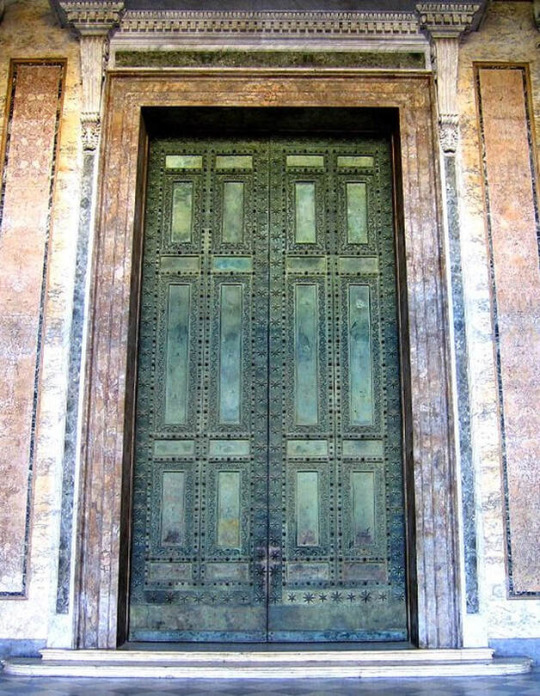
#FOTD#FactoftheDay#Oldest door#Basilica of St John Lateran#I could not find an exact measurement but they are huge. one clip shows a man opening it with the door being 5-6 times his height
1 note
·
View note
Text
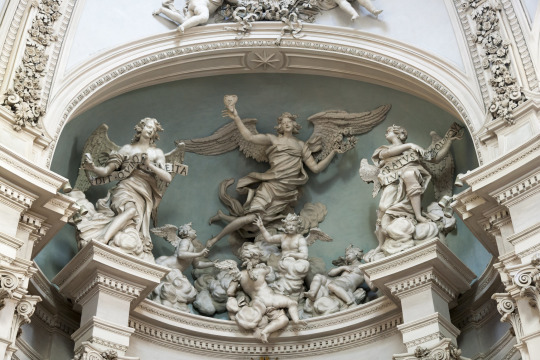
Alcove and statues inside the Papal Archbasilica of St John Lateran, commonly known as St. John Lateran's Basilica
#rome#st john#christentum#christianity#western civilization#art#fine art#fine arts#european art#classical art#europe#southern europe#european#mediterranean#europa#angel#angels
102 notes
·
View notes
Text
Inscribed on the entryway to the portico of the Basilica of St. John Lateran in Rome are the words: Mother and head of all the churches in the city and the world.
This inscription may seem wrong at first. Isn’t St. Peter’s Basilica in the Vatican the pope’s main church?
No, not exactly.
The pope serves as the Bishop of Rome and as the Cathedral of the Diocese of Rome, St. John Lateran is the pope’s church.
First dedicated on this day, November 9th, in the year 324, the original basilica was built on land donated to Constantine by the wealthy Lateran family. That structure and its successors suffered fire, earthquake, and the ravages of war, but the Lateran remained the church where popes were consecrated.
In the 14th century, when the papacy returned to Rome from Avignon, the Basilica of St. John Lateran was found in ruins.
Knowing the profound history that occurred there, Pope Innocent X commissioned the present structure in 1646, rebuilding St. John Lateran to its former glory. One of Rome’s most awe-inspiring churches, the Lateran’s towering facade is crowned with 15 colossal statues of Christ, John the Baptist, John the Evangelist, and 12 Doctors of the Church.
San Giovanni in Laterano Rome

Beneath its high altar rests the remains of the small wooden table on which tradition holds St. Peter himself celebrated Mass.
As Catholics, Rome is the center of our earthly home, the Catholic Church, and we should all foster a feeling of devotion and attachment to the city’s rich and beautiful Catholic heritage! Our Major Basilica Coasters are a unique way to bring the beauty of Rome’s Catholicism into your very own home. Featuring each of the four major basilicas in Rome in a unique ink and watercolor design, these coasters are a thoughtful gift for any lover of Catholic history and art! Get yours today at The Catholic Company!
#The Catholic Company#Catholic#San Giovanni in Laterano Rome#San Giovanni#Laterano#Rome#Laterano Rome#St. PeteR#Tom#TLM
9 notes
·
View notes
Text
The Vatican said on Friday that Pope Emeritus Benedict XVI had rested well and that his condition was unchanged.
In a statement published Dec. 30, the Holy See Press Office said: “Last night the Pope Emeritus was able to rest well. He also participated in the celebration of Holy Mass in his room yesterday afternoon. At present his condition is stationary.”
On Thursday, Pope Francis renewed his invitation to pray for Benedict “and accompany him in these difficult hours.”
At the end of his general audience on Dec. 28, the pontiff had asked for prayers for his predecessor, sparking concerns over the health of the 95-year-old.
The Diocese of Rome announced it will offer a special Mass for Pope Emeritus Benedict XVI at the Basilica of St. John Lateran later on Friday.
39 notes
·
View notes
Text
San Giovanni in Laterano
Today we visited The Basilica of St John Lateran. It is the oldest church in the western world, founded in 342. Its present appearance dates to the 17th century and later. It is considered the most important basilica in Rome, ahead of St Peter’s. The basilica and adjacent palace were home to the pope until the Middle Ages.
The basilica is enormous and beautiful. Today, it was packed with people, all seated on folding chairs and all holding notebooks. Paul approached an usher who explained it was some sort of liturgical retreat for couples. It had started at 9am but was now over (it was noon) but everyone inexplicably continued to sit there. Curious. Or maybe we completely misunderstood his explanation!! He and Paul joked about their own long marriages…it was funnier in Italian!

The outside, while enormous, is nothing special.

Inside, it is beautiful and even more enormous. We will go back when it is not full of people to get a better look.
Next door is the Sancta Sanctorum, which was the original private chapel of the papacy. Over the altar is the Uronica, a painting of the face of Jesus, begun by St Luke but finished by the hand of an angel.
And to reach this chapel, are the Scala Santa, or Sacred Stairs. They are purported to be the stairs that Jesus climbed to meet his judgement by Pilot. They were moved to Rome from Jerusalem. They are covered in wood to save their holiness. Pilgrims climb them on their knees.
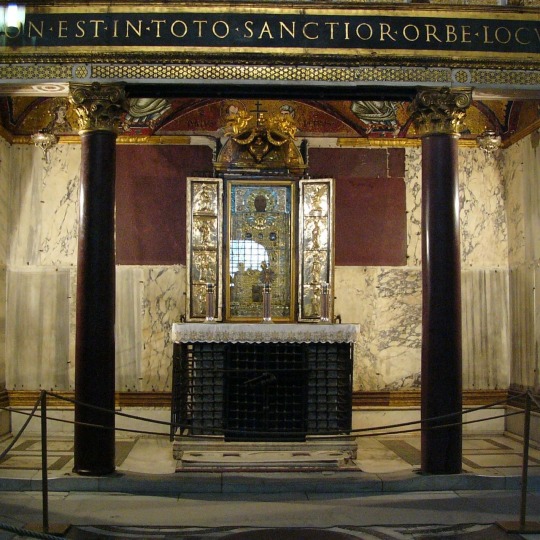
The Sancta Sanctorum altar with the Ursula enshrined over it.
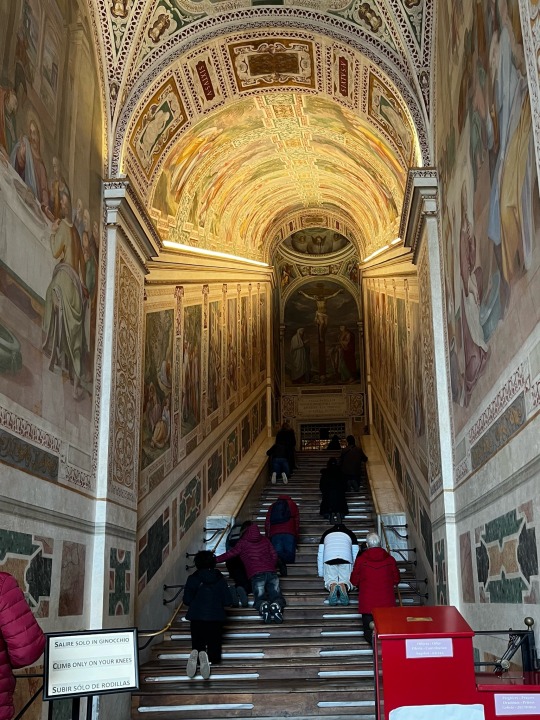
People are climbing the steps on their knees. The stone steps are visible between the wooden protective pieces.

We heathens could walk up a different staircase…

…whose walls held graffiti from the 1600s.
2 notes
·
View notes
Text
DEDICATION OF THE LATERAN BASILICA (Feast) John 2:13-22
Feast of the Dedication of the St. John Lateran Basilica in Rome is a universal feast for the Roman Catholic Church, because it is the Pope’s cathedral, and his church is the spiritual home of the people who are the Church. The first basilica on the site was built in the fourth century when Constantine donated land, he had received from the wealthy Lateran family. That structure and its successors suffered fire, earthquake, and the ravages of war, but the Lateran remained the church where popes were consecrated. In the 14th century when the papacy returned to Rome from Avignon, the church and the adjoining palace were found to be in ruins. Pope Innocent X commissioned the present structure in 1646. One of Rome’s most imposing churches, the Lateran’s towering facade is crowned with 15 colossal statues of Christ, John the Baptist, John the Evangelist, and 12 doctors of the Church. Beneath its high altar rest the remains of the small wooden table on which tradition holds Saint Peter himself celebrated.
We find in the Old Testament as well as in the New Testament, that Temple is always considered a House of God. For the first time God encountered Human beings in the Garden of Eden, but when they profaned that Holy Ground, God chased them out. Since then, human beings always longed to have a House of God. The Ark of the Covenant was considered a mobile temple of God till Solomon completed the Temple of Jerusalem, where the Ark of the Covenant was kept, considering the Holy presence of Yahweh. This was destroyed during Babylonian invasion in 597 BC. And finally, it was completely wrecked by Romans in 70 AD, as Jesus predicted in Mark 13:1,2.
The Gospel reading of today is an incident, where, we find Jesus’ expression of anger, when he finds the temple as market place and a place of exploitation of the poor. However, Jesus becomes the New Temple and we all are called to be the body of the church (Romans 12:5, 1 Corinthians 12:12-27, Ephesians 3:6, 5:23, Colossians 1:18 and 1: 24) “Jesus Christ is seen as the head of the body, which is the church, while the members of the body are seen as members of the Church.” Every baptized person is inducted as member of this CHURCH. “It is no longer I who live, but Christ who lives in me” (Galatians 2:20). Do you know that your body is the temple of the Holy Spirit…. (1Cor. 6:19). It is my responsibility to keep this temple holy and pure. The husk of impurity must be removed before the seed of holiness is generated.
What sort of business do I do and profane my body?
How many years did I take to build this temple without God?
Can I destroy this temple and allow Jesus to rebuild a new temple in me?
PRAYER:
Jesus my Lord, the corner stone of God’s temple, forgive me for turning this temple into market place, where I engage myself trading with anger, revenge, ego, lust, gluttony, greed, laziness, wrath, envy and pride etc. and profane my body. Chase away the darkness of my being and help me to rebuild it with love, compassion, forgiveness, generosity, purity of mind and body. Create in me the zeal for your house till I devour myself in you and enter into new Jerusalem.
2 notes
·
View notes
Text
wildly points at the air explaining how saint peter was crucified upside down and his tomb is said to be the st peter’s basilica and human bones were discovered underneath the building in 1950 but peter’s skull is said to be in the archbasilica of saint john lateran which is actually one of the only if not the only church that ranks above st peter’s basilica (highly regarded as one of the most important structures in christianity because of peter’s importance) and the front wall between the main portals holds a plaque which describes the archbasilica as the “mother church” of all the world and the primary patron of the church is Christ the Savior and the original architecture featured a mosaic of christ handing the keys to the kingdom of heaven to pope sylvester and peter gives the papal stole to pope leo and the layout is divided by rows of columns into aisles
like first of all, there’s a lone skull in the basement of the library
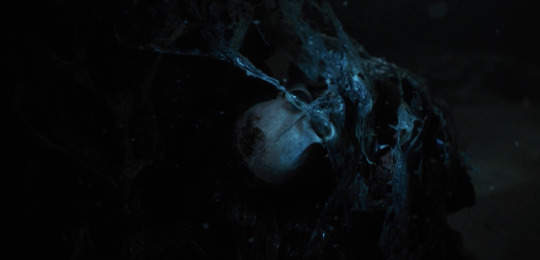
and then there’s a bunch of unidentified bones in the tunnels and we know the library is central to everything for some reason and the primary patron being christ while will is the religious equivalent of christ?? rows divided into columns sounds a lot like shelves to me . however this creates 6 billion more problems
#i know i said i wasn’t gonna ramble but this shit is confusing as hel#i don’t know which aspects of peter’s story they’re trying to utilize in the show or if there’s just hella coincidences#because the timeline doesn’t work. unless they decide to do some time stuff which is very possible#religious imagery
14 notes
·
View notes
Text
On December 31th is the feast day of St. Sylvester I., Pope
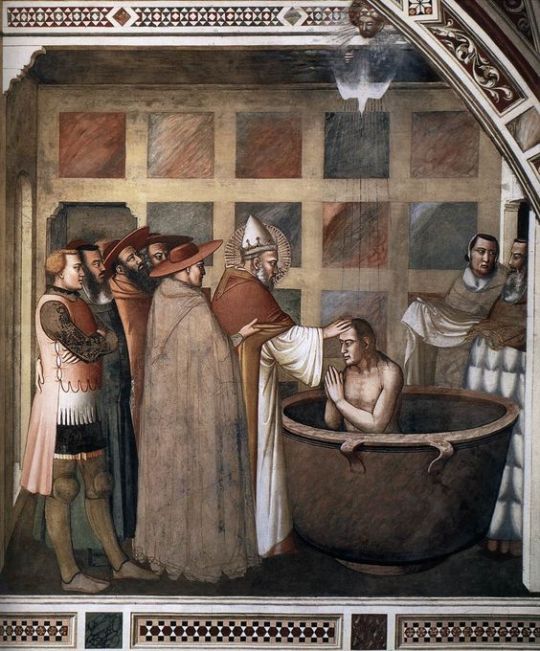
Source of picture: https://italianartsociet.org
Life of St. Sylvester I.
When you think of this pope, you think of the Edict of Milan, the emergence of the Church from the catacombs, the building of the great basilicas—Saint John Lateran, Saint Peter’s, and others—the Council of Nicaea, and other critical events. But for the most part, these events were planned or brought about by Emperor Constantine.
A great store of legends has grown up around the man who was pope at this most important time, but very little can be established historically. We know for sure that his papacy lasted from 314 until his death in 335. Reading between the lines of history, we are assured that only a very strong and wise man could have preserved the essential independence of the Church in the face of the overpowering figure of the Emperor Constantine. In general, the bishops remained loyal to the Holy See, and at times expressed apologies to Sylvester for undertaking important ecclesiastical projects at the urging of Constantine.
Source: https://www.franciscanmedia.org/saint-of-the-day/saint-sylvester-i/
#saints#pope#St. Sylvester I.#God#Jesus#Christ#Jesus Christ#Father#Son#Holy Spirit#Holy Trinity#christian religion#faith#hope#love#stress reliever
11 notes
·
View notes
Text
SAINT OF THE DAY (February 28)

Pope Hilarius (or Hilary) was the bishop of Rome from 19 November 461 until his death on 29 February 468.
Hilary was born in Sardinia, Italy. He was a papal legate to the Robber Council of Ephesus in 449, barely escaping with his life from this affair.
Hilary was used by Pope St. Leo I the Great on many assignments. When Leo died, Hilary was elected pope and consecrated on 19 November 461.
He worked diligently to strengthen the Church in France and Spain, calling councils in 462 and 465.
Hilary also rebuilt many Roman churches and erected the chapel of St. John Lateran.
He also publicly rebuked Emperor Anthemius in St. Peter’s for supporting the Macedonian heresy and sent a decree to the Eastern bishops validating the decisions of the General Councils of Nicaea, Ephesus, and Chalcedon.
Hilary consolidated the Church in Sandi, Africa, and Gaul.
He died on 29 February 468 and was buried in Basilica of St. Lawrence outside the Walls.
3 notes
·
View notes
Text
HOMILY for Dedication of Westminster Cathedral
1 Cor 3:9c-11, 16-17; Ps 46; John 2:13-22

Today’s feast celebrates the Dedication of Westminster Cathedral, the mother church of this diocese. As with every liturgical commemoration of the dedication of a church, there are several points to consider. Firstly, these feasts speak of the communion of Saints, and they are a chance to pray for the strengthening of our relationship of charity, whether with the pope (such as when we celebrate the dedication of the Lateran Basilica), or as a parish community (such as when we celebrate the dedication of this church), or with the Archbishop of Westminster and as a diocese, which is what we do today. So, in a particular way, we pray for this Diocese of Westminster, that we Catholics in London will be a sign of Christ’s mercy, love, and saving power in this part of the world. We also commit ourselves to
Secondly, the feast of the dedication of a church recalls, not so much the building, but the sacred activities that take place within a church, namely, the celebration of the Sacraments. The Sacraments are the primary means of sanctification given by God. Through them, the grace of Christ the Son is given to you and me so that we might be conformed to Christ the Son; so that we might become holy, chosen and set apart from the world so that as a priestly people we can pray for the world, and sanctify the world by acts of love. Our good works, therefore, give glory to God our Father, and are, so to speak, liturgical actions performed in our daily lives.
In the Gospel, therefore, Christ drives the money changers and market traders out of the temple precincts. Why? Because, it seems, although the services they provided were needed for the Temple sacrifices, they had profaned the Temple by providing these services with primarily mercenary and profiteering motives. This is a reminder to us that in the work we do and in the services we provide in the world, we must be careful to do these things with love, with a Christ-centred motive. There is nothing wrong with commercial activity, or secular work in itself - for work is necessary and indeed gainful employment gives dignity to human beings. However, as Christians, we give witness to our faith by doing our jobs with love, with genuine care for the good, with a worthy attitude of giving our best to others, for the glory of God. In this way, our work sanctifies us, and it also makes the places where we work and live to be better, more Godly places. Our workplaces and our homes, therefore, can be hallowed for God when we cause them to become places of hospitality and genuine love for God and one another.
Thirdly, the feast of the dedication of a church recalls that each of us, through the gift of sanctifying grace conferred in the Sacraments, has been hallowed and dedicated and set apart for God. Every Christian, therefore, through Baptism into Christ, is made to be a dwelling place for the Blessed Trinity. Therefore, as St Paul says: “you are the temple of God” because “the Spirit of God dwells in you.” The Holy Spirit has been called the Guest who dwells in us. Therefore, we welcome this great Guest, God himself, by keeping our souls free from sin: daily examine your conscience, repent of venial sins by praying for forgiveness or going to Mass and communion, but if we’re conscious of mortal sins, we must repent and go to confession especially before receiving Holy Communion. In this way, we co-operate with God’s grace so that the Lord can build us up in charity, in genuine love for him and for the whole Church. Today’s feast, therefore, also summons us to this kind of growth in charity.
And finally, there is in St Paul’s statement a warning and a call to protect all human life. Scripture says: “If anyone destroys God’s temple, God will destroy that person; for the temple of God, which you are, is holy.” Many of you will know that last Friday on the feast of the Sacred Heart of Jesus, a tremendous, historic, and epoch-marking event took place in the USA: the notion that abortion should be a right guaranteed by the US Constitution was overturned by the US Supreme Court. This was the fruit of much prayer and sacrifice. From our perspective as Catholics, the human life, which is scientifically verified to begin at conception, is sacred. This is affirmed in several places in the Word of God, such as the reading we heard today, and the understanding that abortion is a dreadful sin has been upheld by Christians from the very beginning, despite the fact that the cultures in which the early Christians lived even practiced infanticide. So, Catholics have always been pro-life, and we strive to support and improve the conditions of human living from conception to natural death, sanctifying our human lives and the societies and communities in which we live, and so giving glory to God the Creator. For every human being has been created in love by God, and Christ shed his precious blood and died for all peoples, so that whoever believes in him will not perish but may have eternal life. Therefore, every human person, no matter how small, is sacred and is to be cherished by us Christians.
Westminster Cathedral was dedicated on this day in 1895, on what was the feast of the Precious Blood of Jesus. Therefore, we trust that the blood of Christ will free us from all sin, no matter how dreadful or serious they may be. So we pray that the blood of Christ will run in our veins so that, having been saved from our sins, we shall be conformed to Christ, transformed by his grace, and thus built up in holiness. And we ask that the blood of Christ will cover us and so be our protection from all evil; let each of us therefore be dedicated to God as a holy dwelling place for the Most High. Amen.
5 notes
·
View notes
Photo
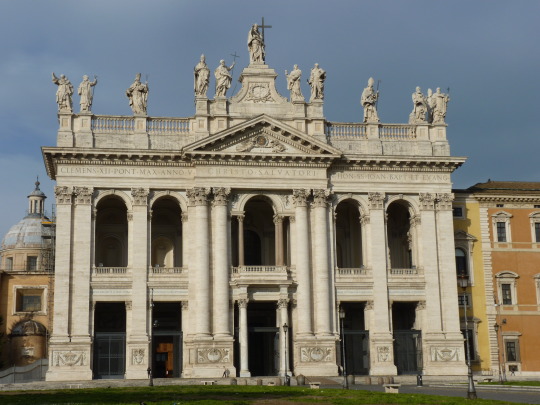
Today’s Flickr photo with the most hits: St John Lateran Basilica, Rome.
1 note
·
View note
Photo
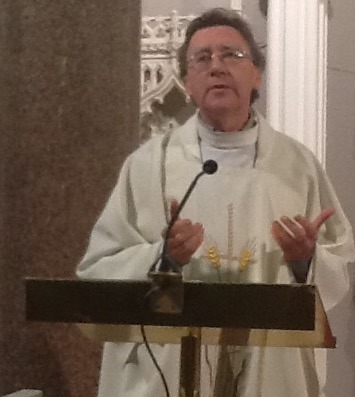
9th November >> Fr. Martin’s Gospel Reflections / Homilies on John 2:13-22 for the Feast of The Dedication of the Lateran Basilica: ‘He was speaking of the sanctuary that was his body’.
Feast of The Dedication of the Lateran Basilica
Gospel (Except USA)
John 2:13-22
Destroy this sanctuary and in three days I will raise it up.
Just before the Jewish Passover Jesus went up to Jerusalem, and in the Temple he found people selling cattle and sheep and pigeons, and the money changers sitting at their counters there. Making a whip out of some cord, he drove them all out of the Temple, cattle and sheep as well, scattered the money changers’ coins, knocked their tables over and said to the pigeon-sellers, ‘Take all this out of here and stop turning my Father’s house into a market.’ Then his disciples remembered the words of scripture: Zeal for your house will devour me. The Jews intervened and said, ‘What sign can you show us to justify what you have done?’ Jesus answered, ‘Destroy this sanctuary, and in three days I will raise it up.’ The Jews replied, ‘It has taken forty-six years to build this sanctuary: are you going to raise it up in three days?’ But he was speaking of the sanctuary that was his body, and when Jesus rose from the dead, his disciples remembered that he had said this, and they believed the scripture and the words he had said.
Gospel (USA)
John 2:13-22
Jesus was speaking about the temple of his Body.
Since the Passover of the Jews was near, Jesus went up to Jerusalem. He found in the temple area those who sold oxen, sheep, and doves, as well as the money-changers seated there. He made a whip out of cords and drove them all out of the temple area, with the sheep and oxen, and spilled the coins of the money-changers and overturned their tables, and to those who sold doves he said, “Take these out of here, and stop making my Father’s house a marketplace.” His disciples recalled the words of Scripture, Zeal for your house will consume me. At this the Jews answered and said to him, “What sign can you show us for doing this?” Jesus answered and said to them, “Destroy this temple and in three days I will raise it up.” The Jews said, “This temple has been under construction for forty-six years, and you will raise it up in three days?” But he was speaking about the temple of his Body. Therefore, when he was raised from the dead, his disciples remembered that he had said this, and they came to believe the Scripture and the word Jesus had spoken.
Reflections (6)
(i) Feast of The Dedication of the Lateran Basilica
The church of Saint John Lateran in Rome is one of the four great Basilicas of the city, the other three being Saint Peter’s Basilica, Saint Mary Major’s Basilica and the Basilica of Saint Paul outside the Walls. It is the Cathedral church of the Pope in his role as Bishop of the Diocese of Rome. It is called ‘Saint John’ after the two monasteries once attached, dedicated to Saint John the apostle and Saint John the Baptist. As the Cathedral Church of the Pope it has the title ‘Mother and Head of all the churches of the City and of the World’. There are many wonderful churches in Rome and throughout the world. Yet, we are all very aware that the church is not primarily a building, no matter how grand. The church is the community of believers who gather in the building we call a church. That is why at the beginning of today’s first reading, St Paul says to the community of believers in Corinth, ‘you are God’s building’. The most impressive physical building of worship among Jews in Paul’s time was the Temple in Jerusalem. Yet, in that same reading, Paul says to the church in Corinth, ‘you are God’s Temple’. Interestingly, in the gospel reading, Jesus, while standing in the magnificent Temple in Jerusalem, identifies himself as the Temple or sanctuary of God, ‘Destroy this sanctuary and in three days I will raise it up’. Jesus was claiming that the place where God dwells among humanity was no longer the physical Temple in Jerusalem but himself. Paul reminds us that we, the community of faith, the members of Christ’s body, are now the place where God wishes to dwell among humanity. As living stones in God’s building, God’s Temple, each one of us is called to reveal God’s loving presence to others. One of the reasons we gather in a building like this, a church, is to receive the grace and strength we need to be true to our calling to be living stones in God’s spiritual building. The Lord needs us to make tangible his loving and merciful presence in our world today.
And/Or
(ii) Feast of the Dedication of the Lateran Basilica
The Lateran Basilica is one of the four great Basilicas of Rome. The original Basilica was erected by the Emperor Constantine, the first Christian Emperor. It is the Cathedral church of Rome and, so, is the church of the Bishop of Rome, the Pope. For that reason, it has come to be known as the mother church of Christendom. Before the time of Constantine there were no public buildings called churches. Christians met in ordinary spaces, such as people’s homes. Writing to the church in Corinth about thirty years after the death and resurrection of Jesus, Paul says to them, in the words of today’s first reading, ‘You are God’s building… God’s temple’. For Paul, it was the Christian community, rather than any physical building, that was the place of God’s presence in the world. In the gospel reading, Jesus points to himself as the Temple of God. He, more than any human being, is the place of God’s presence in the world. As individuals and as a community we look to the Lord to help us to be the place of God’s presence in the world, to be church, in that sense. We gather in a building we call a church, to open ourselves to the presence of the Lord, so that we can become more fully the church of God, the body of Christ, in our world.
And/Or
(iii) Feast of the Dedication of the Lateran Basilica
In the early fourth century the first Christian emperor, Constantine, had a church built on land that once belonged to the Laterani family. That church of Constantine was the precursor of the present Basilica. This Basilica is now the Cathedral of the Diocese of Rome. It is the church of the Pope in his capacity as Bishop of Rome. For that reason, it has the title, ‘mother and head of all the churches of the city and the world’. Our local parish churches are much more modest building that the Basilica of Saint John Lateran in Rome, and, yet, both are equally monuments to people’s faith. In today’s first reading Paul tells the Christians in Corinth, ‘you are God’s building… you are God’s temple’. Paul is reminding us that more fundamental than the building we call church are the people we call church. The church building is there to help us to express our identity as a people of faith, called to worship God through Christ in the Spirit. If our worship is to be authentic, the shape of our worship must become the shape of our lives. Our whole lives are to be a movement towards God, through Christ and in the Spirit. This is what it means to be church, to be the temple of God in the world, the living sign of God’s presence. In the gospel reading Jesus points to himself as the temple of God in the world, the one through whom God is present in the world. This is the heart of our own baptismal calling, to become temples of God through whom God’s loving presence touches the lives of others.
And/Or
(iv) Dedication of Basilica of Saint John Lateran
In the early fourth century the first Christian emperor, Constantine, had a church built on land that once belonged to the Laterani family. That church of Constantine was the precursor of the present Basilica. This Basilica is now the Cathedral church of the Diocese of Rome. It is the church of the Pope in his capacity as Bishop of Rome. For that reason, it has the title, ‘mother and head of all the churches of the world’. Every church building tells a story about the faith community who gather in the building. In that sense today’s feast is less about a church building and more about the people we call church. Paul’s words to the Corinthians this morning are addressed to every parish community: ‘You are God’s building’. For Paul, the local faith community is the Temple of God, where God’s Spirit is dwelling. The local parish church is most itself when it is filled with the people who are the church, the baptized and believing community. Paul in that second reading reminds us that the foundation of the believing community is Jesus Christ. As individual believers and as a community of faith we are called to build our lives on the person of Jesus, by keeping his words and by remaining open to his Spirit. That is our shared baptismal calling. In attending to that calling we give meaning to the building in which we gather.
And/Or
(v) Dedication of Lateran Basilica
Today’s church celebrates the Cathedral church of the Diocese of Rome. It is one of the four major Basilicas in Rome and as the Cathedral church of the Diocese it has a special association with the Pope in his role as Bishop of Rome. It is as Bishop of Rome that he is Pope of the Universal Church. It is a beautiful building the origins of which go back to the first Christian Emperor Constantine. Today’s second reading is from Paul’s first letter to the Corinthians. At the time Paul wrote that letter there were no Christian churches, big or small. The Christian community gathered wherever it could, sometimes in the home of one of its members. In that reading Paul says to the community of faith in Corinth, ‘you are God’s building’. ‘You are God’s temple and the Spirit of God is living among you’. In the gospel reading for today’s feast, Jesus points to himself as the sanctuary or the Temple of God. He is the one in and through whom God is present in a special way. Paul reminds the local church in Corinth that they are now the Temple of God, in and through whom God is present in the world in a special way. Rather than a focus on a building, Paul puts the focus on the community. As a faith community we come to this building which we call a church. Yet, more fundamentally, we are the church, all of us, and the Lord wants to be present in the world in and through us as a community of faith. We are called to live in a way that reflects that wonderful identity in which we all share.
And/Or
(vi) Dedication of Lateran Basilica
We don’t often celebrate the feast of the dedication of a church. However, the basilica of Saint John Lateran is a special church. It is the cathedral church of the Diocese of Rome. Like any diocesan cathedral, it is the church of the bishop of Rome, who, of course, is the Pope. The Basilica is the church of the Pope in his role as Bishop of Rome. For this reason, this particular church has been given a rather long title, ‘Mother and Head of all the churches of the city and of the world’. Why is it sometimes called the Lateran Basilica or the Basilica of Saint John Lateran? The ‘Laterani’ were an old Roman family who probably once owned the land on which Emperor Constantine, the first Christian Emperor, built this Basilica in the early decades of the fourth century. The present Basilica retains the plan given to it by the Constantine but it has been rebuilt and restored over the centuries, and its interior was transformed in the mid-17th century by the famous sculpturer Borromini. If you happen to be in Rome, it is a Basilica well worth visiting. Of the three readings for this feast, only the first reading focuses on an actual building, the Temple in the city of Jerusalem, understood as the place of God’s living presence in the world. In the gospel reading, even though Jesus is present in the Temple in Jerusalem, he places the focus not on the building but on himself, Speaking of himself, he says, ‘Destroy this sanctuary (this temple) and in three days I will raise it up’. Jesus is saying that he is the place where God is truly present in the world, not some building, no matter how sacred. When Paul was writing to the church in Corinth in today’s second reading, there were no Christian buildings in existence. Paul’s focus in that reading is not on any building but on the community of faith, the church. He says to them, ‘You are God’s building…you are God’s Temple’. Paul is saying that the Christian community, the body of Christ, is the place where God is to be truly present in the world. The church is a spiritual temple. Later on in that same letter, Paul addresses each individual member of the church as a temple of the Spirit. If Jesus was the supreme expression of God’s presence in the world, we are each called in our own way to be living expressions of God’s loving presence in our world today. The Lord, now risen, continues to be God’s presence in the world today through each one of us in all our rich diversity.
Fr. Martin Hogan.
4 notes
·
View notes